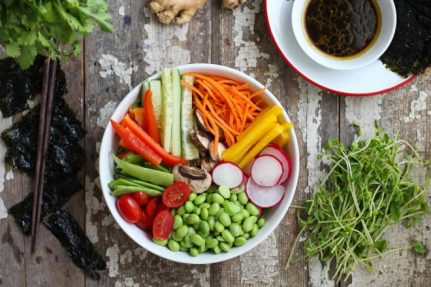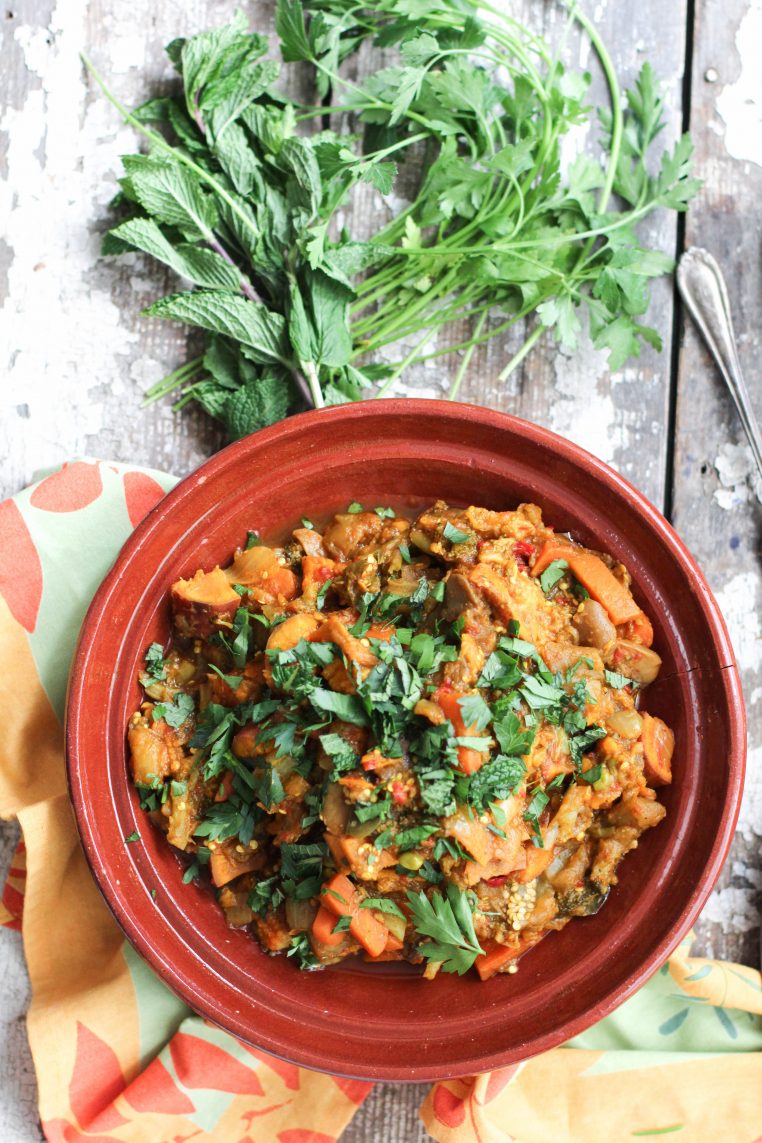Garden Vegetable Tagine is a recipe for a traditional Moroccan vegetarian dish that’s naturally gluten-free and vegan-friendly, served with sweet potatoes, eggplant, and garden vegetables.
This vegetarian tagine recipe is sure to be a weekly staple in your kitchen if you love warming foods and an easy recipe to use up all those veggies you have in the kitchen still.
No vegetable is left out in this dish from root veggies like sweet potatoes to eggplants, peppers, and cauliflower. All of these vegetables stand out on their own in this dish, but a special Moroccan condiment called harissa makes this dish unique and filled with warming spices with a slow and low cooking taste without all the time.
What Is Tagine?
A tagine (or tajine) is a clay pot used in Moroccan cooking that helps the food cooked within it evenly cook and keeps it hot long after cooking. The cone-shaped lid has a purpose, to allow the condensation from the bottom (where the food is) to rise and fall back to the base while cooking.
If you don’t have a tagine in your home, you can simply use a large deep pot with a lid, but having a tagine recreates a traditional feel to the dish and the presentation is gorgeous. Here are a couple tagines that I adore: here and here.
This vegetable tagine recipe is a great one to keep in your fall and winter rotation when you want to make large amounts of healthy recipes for quick leftovers and a busy week ahead. What you’ll love most about this dish is the flexibility. When eating a diet that’s mostly from plant sources, it’s still nice to enjoy farm fresh eggs and wild caught fish, but this veggie-based tagine makes it suitable for everyone.
This tagine dish is perfect for those of you living a vegan lifestyle, vegetarian, plant-based, paleo, etc. It surpasses all “diets” and is universally delicious for everyone. You can easily add in proteins of your choice to make this meal complete and more hearty. Below I’ll share some variations to add per serving to make this more of a hearty meal.
It’s also great for making on your batch cooking day for reheating later or sharing with the family.
The Secret Tagine Ingredient: Harissa
Harissa gives an important flavor in this dish. It’s what sets a normal vegetable mash apart from vegetable tagine. Harissa essentially is a Moroccan condiment/sauce that is used in countless ways. You can, of course, make harissa homemade. But if you’re looking for convenience without sacrificing any of the flavors, then one of my favorite brands is Mina Harissa which is found in most stores and super easy to use.
You can use harissa by stirring it into hummus, dipping roasted veggies into it, adding it to egg or tofu scrambles, stirring into beans, or using it as a marinade for tempeh.
Harissa is an incredibly healthy condiment as well. It’s made from only whole food ingredients you can pronounce and most likely have stocked in your pantry such as chilies, peppers, vinegar, olive oil, garlic, and salt. The spices and spice blends also give this dish amazing depth of flavor thanks to the ultimate Moroccan spice blend, ras el hanout, which means “the head of the shop”.
In a nutshell, this tagine recipe uses the best spices all together in one blend — including cinnamon, cardamom, ginger, pepper, chili, coriander, and more.
Cooking Plant-Based Meals with Harissa
In Moroccan cuisines, it’s traditional to have spicy and sweet components all within one dish. I incorporated that notion that by adding heaps of sweet potatoes to this recipe that create an amazing balance of flavors between the heat from the harissa and subtle sweetness from the sweet potatoes.
I love using eggplant in this dish as well. If you’re new to eggplant I promise using it in this recipe will be delicious, and it gives it a thick and meaty density to it that would be lacking if you left it out.
I highly recommend serving your tagine with a great protein like tempeh, beans, hemp seeds, chickpeas, eggs, wild caught fish, etc. Also, try serving this dish on top of a bed of fluffy quinoa, rice (jasmine, basmati, or wild rice), millet, or even plain on top of dark leafy greens like spinach.

















